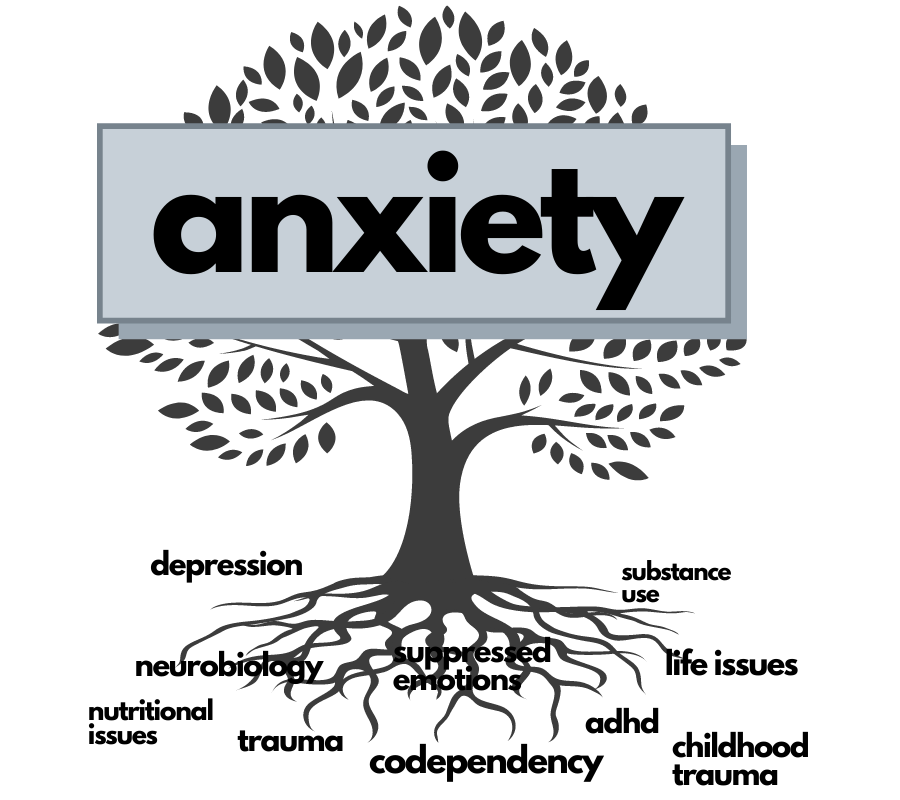
Anxiety Root Causes
Module I | Session 5
Overview
M1 | Session Five: Fear - Anxiety Root Causes
|
The Deep Roots Of Anxiety
Comorbidities
Correlations
Session Skill: Journaling
|
Comorbidity
Comorbidity refers to the occurrence of more than one disorder at the same time. It may refer to co-occurring mental disorders or co-occurring mental disorders and physical conditions.
Source: Health.gov.au

Anxiety & Comorbidity
Many illnesses and behaviors often grow alongside anxiety.
Many illnesses can come from the existing thought patterns of chronic anxiety.
The daily struggles of living with other conditions can spawn anxiety symptoms, causing combinations called comorbidities.
Comorbidities are simultaneously occurring illness that may or may not fuel anxiety.
Comorbidities are often highly correlated with anxiety; however, correlation does not equal causation.
Just because two things correlate does not necessarily mean that one causes the other.
A correlation between two things can be caused by a third factor that affects both of them… (ie. genetics or environment)
Often, anxiety is triggered by major traumatic life events, such as a loss of someone, an injury, or major financial troubles.
Anxiety often develops over time, alongside some of these chronic conditions:
DEPRESSION
ADHD
ALCOHOL & DRUG ADDICTION
EATING DISORDERS
EMOTIONAL HABITS
GUILT OR SHAMING
CODEPENDENCY
MAJOR LIFE TRANSITIONS
DIFFICULT LIFE CIRCUMSTANCES
Correlation
It is important to remember that correlation does not equal causation. However, the following have been found to be closely associated with anxiety. As you go through each descriptor, consider if any of them apply to you in your experience.
|
Depression
Depression is the most common double diagnosis with anxiety. Anxiety and depression are similar in how they work. They can both affect our moods, but they cause different types of disruption. While depression causes numb or irritated feelings, fatigue, and low energy, anxiety can make you hyper-vigilant and constantly worried. Though the symptoms are different, the same negative thinking patterns that drive anxiety can also often drive depression in a different way.
|
ADHD
ADHD connects to anxiety because often ADHD symptoms can create a poor fit with social requirements, causing the person to constantly feel nervous and uncertain. Society requires a person with ADHD to sit still for hours at a time in an office or classroom. This is not natural for this brain type. Trying to suppress natural inclinations, or not being able to, can lead to a lifetime of self-criticism and poor performance. This can lead to negative beliefs about one’s personal abilities, especially if someone is undiagnosed. A lack of understanding of how you work, and societies’ failure to accommodate this learning style, can cause negative thought patterns of worthlessness, guilt, and inferiority that can worsen and intensify anxiety over time.
|
Addiction
Addiction generally includes legal or illegal substances and activities (i.e. eating, gaming, shopping, technology usage, etc.) that drive chemical reactions in the brain or body that is detrimental to one's long-term health. Anxiety may fuel addiction and addiction can also fuel anxiety. Addiction and anxiety are often twin diseases. People may feel driven to self-medicate anxiety with addiction, most dangerously with drugs and alcohol. Furthermore, these addictions can worsen anxiety, especially when the person is sober or not engaging in the compulsive behavior. When in recovery, it is often necessary to increase other healthy coping mechanisms to prevent spikes in anxiety levels.
|
Eating Disorders
Eating disorders include anorexia, bulimia, and binge eating. Much like with alcohol & drug addiction, eating disorders can work as a self-medication for anxiety. It is important to address and resolve core triggers which make a person anxious and more likely to engage in disordered eating. Addressing negative thought patterns, seeing a professional, and staying engaged in positive, fulfilling, and mindful activities help to battle these devastating diseases.
Emotional Habits
Anxiety often occurs with learned emotional habits from our family of origin. This plays a large role in how we behave because these are the only ways we know to cope with life. We often grow up in emotionally unhealthy or unsafe environments which spike our anxiety as we are always on the lookout for danger, harsh reactions, or triggers that lead to abuse. These habits tend to persist even when no longer in the environment.
|
Guilt and Shame
Being in an environment where one is constantly being made to feel guilty or ashamed may also be a factor for anxiety spikes, panic attacks, or other symptoms. Emotions like guilt, shame, inferiority, and vulnerability fuel anxiety. If someone constantly tries to control you through guilt trips and humiliation, this may create deep seated fear reactions that generate acute or chronic anxiety. |
Codependency
(“Unprocessed Trauma”)
Codependency is a pattern of having poor boundaries in relationships. This dynamic tends to fuel chronic anxiety. Often, having poor boundaries is a learned behavior that stems from childhood. This usually involves an environment that constantly breaks healthy boundaries and teaches you that you and your personal boundaries do not matter. This can cause one to be attracted to unhealthy situations because it feels most familiar to them. This usually causes us to develop negative beliefs about ourselves. Codependency, depression, anxiety, and PTSD all are often intertwined in varying combinations, causing problematic thought patterns, worries about a partner’s moods or reactions, creating a constant state of anxiety.
|
Major Life Challenges
Experiencing any kind of adverse or unpleasant event can trigger anxiety in the short or long term. Anxiety can also be triggered by significant changes in our lives. Illness, death, relocation, home loss, perceived failures, and relationship loss are all examples of these distressing changes. These changes are often out of our control, and are unwelcome. The way we handle our grief over these difficult issues can result in us getting stuck in our emotions. Thus, difficulty adjusting to major life changes can be a significant factor in developing anxiety.
|
Difficult Life Circumstances
Poverty, divorce, abuse, or other family stressors create mental stresses that correlate strongly with anxiety. Vulnerable populations such as the poor, disabled, homeless, etc. are more likely to suffer from anxiety, among other diagnoses. Dealing with difficult issues, whether temporary or long-term, may promote a feeling of safety and relief, lowering anxiety levels.
Session Skill
After reading the descriptions of causation and correlations above, do some self reflection to determine if any of the above apply to you and your current symptoms.
Root Cause Journaling
After doing some research on your chosen co-morbidity, do a quick journal on the following questions:
|
Which comorbidity applies to your experience?
How has it affected your life?
Where do you believe this might stem from?
What have you used to cope, if anything?
|
LEARN MORE
Learn more about these issues and resource available to help at the links attached.
